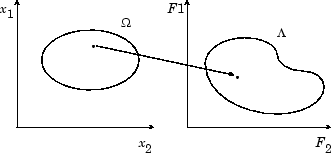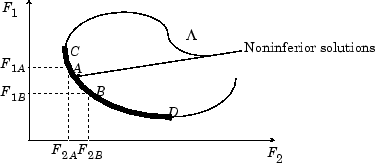什么是多目标优化?
您可能需要用多个目标来制定问题,因为具有多个约束的单个目标可能无法充分代表所面临的问题。如果是这样,就存在一个目标向量,
| F(x) = [F1(x), F2(x),...,Fm(x)], | (1) |
多目标优化涉及目标向量 F(x)的最小化,该向量可能受到许多约束或边界的影响:
请注意,因为 F(x) 是一个向量,如果 F(x) 的任何分量存在竞争,那么这个问题就没有唯一的解。相反,必须使用 Zadeh [4] 中的非劣性概念(在 Censor [1] 以及 Da Cunha 和 Polak [2] 中也称为帕累托最优)来描述目标。非劣解是指一个目标的提高需要另一个目标的降低。为了更精确地定义这个概念,考虑参数空间中的可行域 Ω。x 是满足所有约束的 n 维实数 的一个元素,即
受
约束。这允许为目标函数空间 Λ 定义相应的可行域:
性能向量 F(x)将参数空间映射到目标函数空间,如图 图 14-1: 从参数空间映射到目标函数空间 中的二维所示。
图 14-1: 从参数空间映射到目标函数空间

现在可以定义一个非劣解点。
定义:如果 x* 的某个邻域中不存在 Δ x 使得 和
,则点 为非劣解
在图 图 14-2: 非劣解集 的二维表示中,非劣解集位于 C 和 D 之间的曲线上。点 A 和 B 表示特定的非劣点。
图 14-2: 非劣解集

A 和 B 显然是非劣解点,因为一个目标 F1 的改进需要另一个目标 F2 即 F1B < F1A, F2B > F2A 的退化。
由于 Ω 中任何一个劣点都代表着可以在所有目标上取得改进的点,因此很明显这样的点是没有价值的。因此,多目标优化涉及非劣解点的产生和选择。
非劣解也称为帕累托最优。多目标优化的一个总体目标是构建帕累托最优。